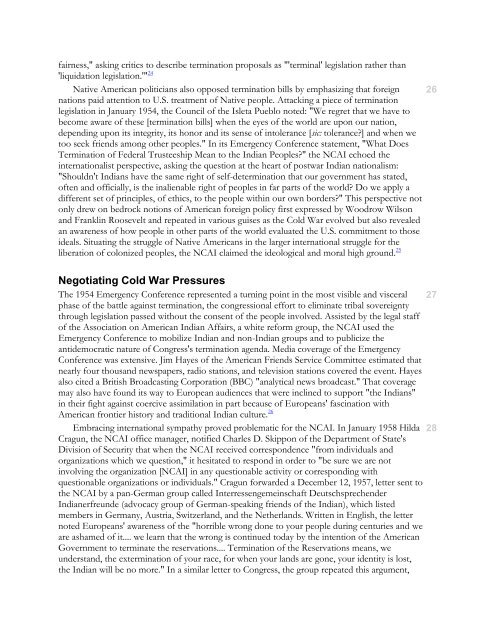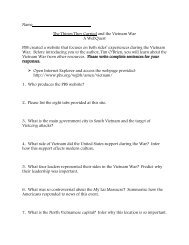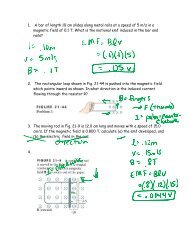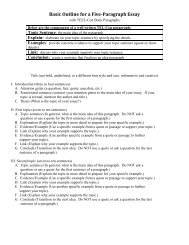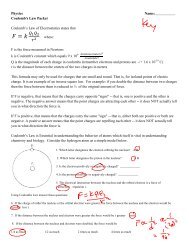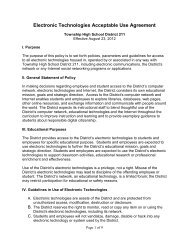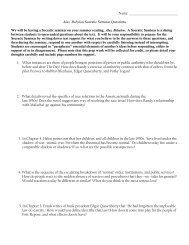Lesson Plan: Indian Activism during the Cold War - Schaumburg ...
Lesson Plan: Indian Activism during the Cold War - Schaumburg ...
Lesson Plan: Indian Activism during the Cold War - Schaumburg ...
Create successful ePaper yourself
Turn your PDF publications into a flip-book with our unique Google optimized e-Paper software.
fairness," asking critics to describe termination proposals as "'terminal' legislation ra<strong>the</strong>r than'liquidation legislation.'" 24Native American politicians also opposed termination bills by emphasizing that foreign 26nations paid attention to U.S. treatment of Native people. Attacking a piece of terminationlegislation in January 1954, <strong>the</strong> Council of <strong>the</strong> Isleta Pueblo noted: "We regret that we have tobecome aware of <strong>the</strong>se [termination bills] when <strong>the</strong> eyes of <strong>the</strong> world are upon our nation,depending upon its integrity, its honor and its sense of intolerance [sic: tolerance?] and when wetoo seek friends among o<strong>the</strong>r peoples." In its Emergency Conference statement, "What DoesTermination of Federal Trusteeship Mean to <strong>the</strong> <strong>Indian</strong> Peoples?" <strong>the</strong> NCAI echoed <strong>the</strong>internationalist perspective, asking <strong>the</strong> question at <strong>the</strong> heart of postwar <strong>Indian</strong> nationalism:"Shouldn't <strong>Indian</strong>s have <strong>the</strong> same right of self-determination that our government has stated,often and officially, is <strong>the</strong> inalienable right of peoples in far parts of <strong>the</strong> world? Do we apply adifferent set of principles, of ethics, to <strong>the</strong> people within our own borders?" This perspective notonly drew on bedrock notions of American foreign policy first expressed by Woodrow Wilsonand Franklin Roosevelt and repeated in various guises as <strong>the</strong> <strong>Cold</strong> <strong>War</strong> evolved but also revealedan awareness of how people in o<strong>the</strong>r parts of <strong>the</strong> world evaluated <strong>the</strong> U.S. commitment to thoseideals. Situating <strong>the</strong> struggle of Native Americans in <strong>the</strong> larger international struggle for <strong>the</strong>liberation of colonized peoples, <strong>the</strong> NCAI claimed <strong>the</strong> ideological and moral high ground. 25Negotiating <strong>Cold</strong> <strong>War</strong> PressuresThe 1954 Emergency Conference represented a turning point in <strong>the</strong> most visible and visceral 27phase of <strong>the</strong> battle against termination, <strong>the</strong> congressional effort to eliminate tribal sovereigntythrough legislation passed without <strong>the</strong> consent of <strong>the</strong> people involved. Assisted by <strong>the</strong> legal staffof <strong>the</strong> Association on American <strong>Indian</strong> Affairs, a white reform group, <strong>the</strong> NCAI used <strong>the</strong>Emergency Conference to mobilize <strong>Indian</strong> and non-<strong>Indian</strong> groups and to publicize <strong>the</strong>antidemocratic nature of Congress's termination agenda. Media coverage of <strong>the</strong> EmergencyConference was extensive. Jim Hayes of <strong>the</strong> American Friends Service Committee estimated thatnearly four thousand newspapers, radio stations, and television stations covered <strong>the</strong> event. Hayesalso cited a British Broadcasting Corporation (BBC) "analytical news broadcast." That coveragemay also have found its way to European audiences that were inclined to support "<strong>the</strong> <strong>Indian</strong>s"in <strong>the</strong>ir fight against coercive assimilation in part because of Europeans' fascination withAmerican frontier history and traditional <strong>Indian</strong> culture. 26Embracing international sympathy proved problematic for <strong>the</strong> NCAI. In January 1958 Hilda 28Cragun, <strong>the</strong> NCAI office manager, notified Charles D. Skippon of <strong>the</strong> Department of State'sDivision of Security that when <strong>the</strong> NCAI received correspondence "from individuals andorganizations which we question," it hesitated to respond in order to "be sure we are notinvolving <strong>the</strong> organization [NCAI] in any questionable activity or corresponding withquestionable organizations or individuals." Cragun forwarded a December 12, 1957, letter sent to<strong>the</strong> NCAI by a pan-German group called Interressengemeinschaft Deutschsprechender<strong>Indian</strong>erfreunde (advocacy group of German-speaking friends of <strong>the</strong> <strong>Indian</strong>), which listedmembers in Germany, Austria, Switzerland, and <strong>the</strong> Ne<strong>the</strong>rlands. Written in English, <strong>the</strong> letternoted Europeans' awareness of <strong>the</strong> "horrible wrong done to your people <strong>during</strong> centuries and weare ashamed of it.... we learn that <strong>the</strong> wrong is continued today by <strong>the</strong> intention of <strong>the</strong> AmericanGovernment to terminate <strong>the</strong> reservations.... Termination of <strong>the</strong> Reservations means, weunderstand, <strong>the</strong> extermination of your race, for when your lands are gone, your identity is lost,<strong>the</strong> <strong>Indian</strong> will be no more." In a similar letter to Congress, <strong>the</strong> group repeated this argument,


